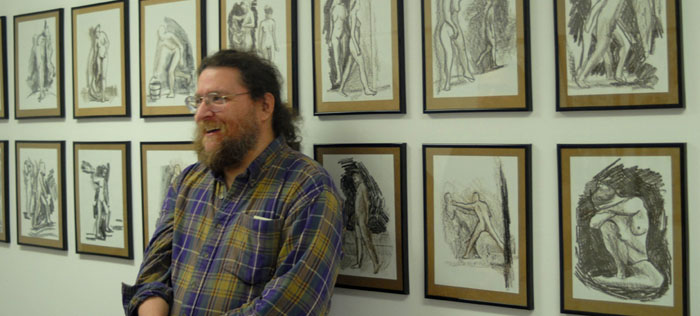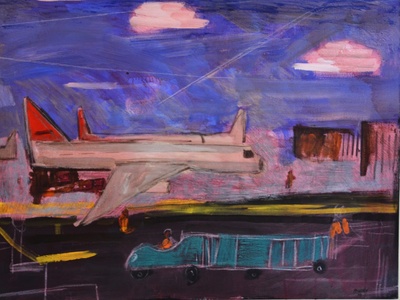Essays in Composition, Plays of Geometry

Marc Awodey, 2007.
One of the first works of art I ever bought was View of a Park (1985) by Marc Awodey. Pearl Street in Burlington, Vermont, ends with a vista of Lake Champlain and the Adirondack Mountains from a rocky perch that hangs over the city’s waterfront. There sits Awodey’s subject, Battery Park. Built on the site where, during the War of 1812, American gunners defended the city against the British with artillery and the USS President in Lake Champlain below, the land was handed to the city and made into a park in 1870. It is not a large park, but it boasts a promenade, a playground, and an eight-foot bronze statue of Vermont’s famous Civil War general, William W. Wells. A half-shell hosts concerts in the summer. Rudyard Kipling claimed to have viewed one of the two finest sunsets he had ever seen from that site.
Awodey’s painting is not of sunsets or the lake or the gorgeous view of mountains in the distance. Awodey painted a field of green with a strip of blue, a brown curve for the promenade, a cannon in the foreground with a few quick strokes for a flag, and a dozen white strokes for birds. Two cars are crudely drawn in the parking lot of the red building on the right of the work. The perspective is as if the viewer is floating above the park. The main action of the painting is a group of blue lines at various angles on short strokes of red, which are topped with beige dots representing children on the playground.
Such was the sort of painter Awodey was. Rather than the grandiose, his subjects are people, places, and things in the vernacular: a grocer stocking meat at a market, apple pickers working off ladders, a woman sitting in a chair with a cat. But really, Marc’s paintings are not about anything and his subjects are simply an excuse to create.
Awodey was a cultural jack-of-all-trades. He was an art critic who wrote hundreds of reviews for Vermont’s alternative weekly, Seven Days, and was a stalwart contributor to Art New England over the years. He was a teacher who taught painting at Burlington College, the Community College of Vermont, Johnson State College, and at various community education programs. He was a poet who wrote three books and won the title of Haiku Champion at the 2000 National Poetry Slam. In the nineties, he cofounded an art gallery, Burlington’s First Friday Art Walk, and a small press that focused on New England writers. He dabbled in politics and was a man about town who made the rounds with a two-liter bottle of Diet Coke.
Before and above all of these things, Awodey was a painter. A retrospective of his work was on view at Christine Price Gallery at Castleton State College in March 2013 and at Art’s Alive Gallery at Main Street Landing’s Union Station in April and May 2013. The exhibition was curated by Mark Waskow and includes paintings from the Waskowmium, private collections, and the artist’s estate. The works represented Awodey’s various genres and styles (figurative, still life, landscapes, etc.), but as curator, Waskow says, “the content of his work was, most often, of no consequence to him.”

Marc Awodey, Purple Girl, 2008, acrylic on canvas.
Awodey saw himself as a formalist. He took shelter in German expressionists and the fauves. He studied under George Earl Ortman, the hard edge, minimalist, constructivist at Cranbrook Academy of Art, Michigan. His still-life paintings are essays in composition. They are plays of geometry. A green bottle, a brown pitcher, a spray of purple flowers, two wine glasses, and assorted citrus constitute the nominal subject of White Pitcher (2009). The objects sit on a lime-green runner on a black table. The background is three fields of color—black, white, and blue—and the action of the painting is cut by the arrangement of the bottle, pitcher, and flowers, which part the canvas from about a third of the way from the top left to about a third of the way from the bottom right. The painting plays with the mathematical idea of the golden ratio, while suggesting the philosophical notion of the golden mean (i.e., the desirable middle between two extremes). That the pitcher in a painting called White Pitcher isn’t white at all is a mark of his humor. He was self-deprecating. In the frame of Still Life Alfredo he inscribed, “There is no higher mission than quality control.––Awodey MFA.” He later framed a series of abstract works with duct tape. He rejected the pretense of the art world, which may have been why he was so comfortable in Vermont. He also resisted artist statements. “My only intention is to make a picture that works, that’s a functional picture,” he said.

Marc Awodey, Airport, 2009, acrylic on canvas.
Despite Awodey’s proclamations against narrative, his paintings often force the viewer to consider story-telling. A man wearing a scarf and hat walks towards the viewer in Leaving Home (mid-1980s). A red house stands in the background. The land is rendered in wavy blues and black tree trunks shake against rough purples in the background. The painting asks, “Who is this man and where is he going?” The scene is emotionally charged, yet ambivalent about so many details: Is it night or a dark winter day? Is the wavy light blue across the bottom of the canvas a path or a river? Is the man happy or sad about leaving? For an artist who resisted narrative, Awodey laced his figurative paintings with its potential.
“The main things that I tend to be concerned about are color, space, mass. How those things are arranged on the picture plane or in the picture plane becomes composition,” Awodey said. “That’s the basic thing: color, space, mass, line, texture, tactile qualities. Those are the elements that go into making a picture, whether the picture works or not. Ultimately those things get wrapped up into composition.”
Ric Kasini Kadour is an artist and writer based in Montreal, Québec and Burlington, Vermont. He is the owner of Kasini House, a creative production company.
